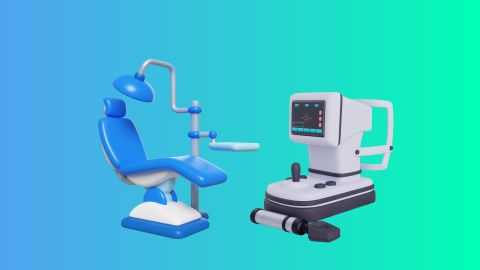Ultrasound machines are vital diagnostic tools that generate real-time images of internal organs using high-frequency sound waves—without exposing patients to radiation. This guide offers a detailed overview tailored for healthcare professionals, outlining various types of ultrasound machines (2D, 3D, 4D, Doppler, and portable), their clinical applications, advantages, and essential buying factors. It also covers key components, current pricing trends in India, necessary legal certifications under the PCPNDT Act, and available financing solutions. Whether you're launching a new clinic or upgrading your diagnostic setup, this guide equips you with the knowledge to make informed, compliant, and patient-focused purchasing decisions. In this article, we will dive deep into the world of ultrasound machines, exploring their meaning, uses, benefits, and a comprehensive buying guide. Additionally, we will look at the current ultrasound machine price range and financing options, including the Bajaj Finserv Medical Equipment Finance solution.
What is an Ultrasound Machine?
The ultrasound machine, also known as a USG, sonography, or ultrasonography device, is a medical imaging tool used to perform ultrasound examinations. It creates real-time images of internal organs and structures using high-frequency sound waves. This non-invasive procedure involves placing a probe on the skin over the area being examined. The sound waves travel through the body and are converted into detailed images, revealing fluids, soft tissues, and internal organs. These visuals help doctors accurately diagnose medical conditions. Ultrasound machines are widely used during pregnancy to monitor fetal development and are also employed to examine organs such as the heart, liver, kidneys, and other vital body systems.
Types of Ultrasound Machines and which one to buy?
The USG machine is available in various types, each designed for specific medical applications.
- 2D Ultrasound Machine: This type of echography machine generates two-dimensional images and is widely used for routine diagnostic imaging.
- 3D Ultrasound Machine: It produces three-dimensional images and allows scanning of tissue cross-sections from multiple angles, offering more detailed visuals.
- 4D Ultrasound Machine: This machine adds the fourth dimension—motion—creating highly realistic moving images. Most 4D ultrasound devices are integrated with 3D technology.
- Doppler Ultrasound Machines: These are specifically designed to measure blood flow and assess pressure within blood vessels, unlike standard 2D or 3D machines.
- Colour Doppler Ultrasound Machine: Converts sound waves into color-coded visuals to show speed and direction of blood flow in real time.
- Power Doppler Ultrasound Machine: Offers more sensitivity in detecting blood flow but does not display flow direction.
- Spectral Doppler Ultrasound Machine: Displays blood flow as a graph, useful in detecting and measuring blockages in blood vessels.
For cardiac-related imaging, the Echo Machine (also known as an echocardiogram machine) is used to evaluate heart function and diagnose conditions like chest pain, shortness of breath, or irregular EKG results.
In addition to imaging, life-saving devices like AED defibrillators are essential in emergency settings for restoring normal heart rhythm during sudden cardiac arrest.
Uses of Ultrasound Machine
An ultrasound machine is versatile and can be used in a variety of medical scenarios:
- Obstetrics and gynaecology: Monitoring foetal development and diagnosing issues in pregnancy.
- Cardiology: Evaluating heart function and detecting abnormalities.
- Abdominal imaging: Diagnosing issues related to the liver, kidneys, pancreas, and other abdominal organs.
- Musculoskeletal imaging: Examining muscles, joints, and soft tissues.
- Guidance for procedures: Assisting in needle placements for biopsies and other invasive procedures.
Medical practitioners who rely on such diagnostic equipment should ensure compliance with government norms, such as those provided by the CDSCO.
Benefits of Ultrasound Machine
- Non-invasive: No need for incisions or injections.
- No radiation: Safe for repeated use, including during pregnancy.
- Real-time imaging: Immediate results for quick diagnosis.
- Portable options available: Suitable for mobile healthcare units.
- Cost-effective: Compared to other imaging techniques, it is more affordable.
Healthcare centers that offer ultrasound often also provide treatments requiring equipment such as dialysis machines for patients with chronic kidney conditions.
Components of Ultrasound Machine
Over the past several decades, ultrasound scanning technology has advanced remarkably. Modern ultrasound machines are now more compact, while the images they produce are far more detailed, high-quality, and vivid than before. Typical components of an ultrasound machine include:
- Transducer
The transducer is the critical component that both sends and receives sound waves. This small, handheld probe used by the technician was once split into two separate devices for transmitting and receiving in early models.For advanced cardiac care applications where image guidance is required, hospitals may also integrate systems like an intra-aortic balloon pump to support critical patients. - Central Processing Unit (CPU)
Often regarded as the brain of the ultrasound machine, the CPU coordinates the signals emitted and received by the transducer, converting electrical signals into clear, visual images on the monitor. - Display
The monitor shows the real-time image captured by the transducer, enabling doctors to examine the scanned area and make informed diagnoses. It also allows technicians to precisely locate the area that needs imaging. - Control Knobs
Control knobs allow the technician to adjust various settings, including zoom and image clarity, to ensure that the displayed image is sharp and detailed. - Keyboard
A keyboard is used during the scan to enter patient data. This ensures that each image is accurately saved in the patient’s file, facilitating proper record keeping on digital platforms.Clinics using digital diagnostics often also adopt respiratory support devices like a cpap machine for sleep apnea management. - Printer
Finally, the printer produces a hard copy of the ultrasound image. These printed images can be reviewed by another doctor or archived in the patient’s file, and they are often given to expecting parents as a keepsake of their child.
How an Ultrasound Machine works
An ultrasound machine directs high-frequency sound waves at the body’s internal structures. These sound waves are emitted and received by a small, hand-held probe called a transducer. The transducer sends sound waves into the body, which bounce back as echoes when they hit tissues or organs. The machine then processes these echoes to create an image on the monitor, helping healthcare professionals diagnose and monitor various conditions.
Prices of Ultrasound Machine
Ultrasound Machine Type |
Approximate Price Range (INR) |
| 2D Ultrasound Machine | Rs. 5 lakh - Rs. 15 lakh |
| 3D Ultrasound Machine | Rs. 12 lakh - Rs. 25 lakh |
| 4D Ultrasound Machine | Rs. 20 lakh - Rs. 35 lakh |
| Portable Ultrasound Machine | Rs. 3 lakh - Rs. 10 lakh |
| Doppler Ultrasound Machine | Rs. 7 lakh - Rs. 20 lakh |
For a detailed list of ultrasound machine prices, you can check out this ultrasound machine price list in India guide.Understanding the full cost structure of other devices, such as breathing support tools, is also essential—check the current cpap machine price to compare features and affordability.
Required certificates for purchasing a hospital ultrasound machine
Here are the essential certifications and approvals required when purchasing an ultrasound machine for hospital use in India:
- Registration under the PNDT Act: Mandatory for any facility conducting pre-natal diagnostics to prevent misuse of ultrasound for sex determination.
- Clinic or Hospital Registration Certificate: Valid proof of medical establishment issued by local health authorities or municipal corporation.
- Radiologist or Sonologist Qualification Documents: Proof of medical qualifications of the professionals who will operate the ultrasound machine.
- Form F Maintenance Approval: Hospitals must maintain and submit Form F records as per PNDT compliance for each scan conducted.
- IEC Certificate (Import Export Code): Required if the ultrasound machine is being imported from another country.
- GST Registration Certificate: Mandatory for financial transactions and claiming input tax credits if applicable.
- Purchase and Maintenance Records: Documentation related to the machine's purchase, installation, and routine maintenance for compliance audits.
Essential Maintenance Steps for Ultrasound Machine
Proper maintenance is crucial to ensure the efficiency, accuracy, and longevity of your ultrasound equipment. Follow these key steps to keep the system in optimal condition:
- Check connections: Regularly inspect all cables and connections, replacing any damaged components immediatey.
- Examine the probe: Inspect the probe and its connectors for tears or damage, and adhere to correct cleaning and sterilisation procedures.
- Clean and inspect: Wipe the machine thoroughly after each use and promptly report any operational issues to the service technician.
- Perform system backups: Carry out routine data backups to minimise downtime in case of technical faults.
- Schedule regular maintenance: Arrange quarterly servicing and cleaning by an authorised representative. Clean filters, air vents, and brackets regularly to prevent overheating and ensure consistent system performance.
Buying guide for Ultrasound Machine
When buying an ultrasound machine, consider the following factors:
- Purpose: Select the machine based on specific medical applications.
- Image quality: Higher-end machines offer better resolution.
- Portability: Consider portable models for mobility.
- Budget: Plan according to the available budget.
- Brand and warranty: Opt for reputable brands with good after-sales support.
Clinics planning to expand their diagnostic capabilities often benefit from investing in diverse medical technologies, including cpap machines for sleep-related therapies.
Difference between Ultrasound machine and CT Scan Machine
Feature |
Ultrasound Machine |
CT Scan Machine |
Technology Used |
High-frequency sound waves |
X-rays and computer processing |
Imaging Type |
Real-time 2D or 3D moving images |
Cross-sectional (slice-like) static images |
Radiation Exposure |
No radiation (safe for pregnant women) |
Involves ionizing radiation |
Best For |
Soft tissues, pregnancy, abdominal organs, blood flow |
Bones, lungs, brain, internal injuries, cancer |
Image Detail |
Less detailed; limited in deeper tissues |
High-resolution, highly detailed images |
Portability |
Usually portable and lightweight |
Typically large, non-portable machines |
Cost |
Generally less expensive |
More expensive than ultrasound |
Scan Duration |
Quick (5–30 minutes) |
Slightly longer (10–30 minutes) |
Contrast Dye Use |
Rarely used |
Often used for enhanced imaging |
Common Use Cases |
Pregnancy monitoring, gallstones, kidney function |
Head trauma, cancer detection, internal bleeding |
Limitations |
Not effective for gas-filled or bone-covered areas |
Not ideal for pregnant women or repeated exposure |
Financing options for buying an Ultrasound Machine
Purchasing an ultrasound machine can be a significant investment. Bajaj Finance offers Medical Equipment Finance options to ease this burden. With competitive interest rates and flexible repayment plans, financing through Bajaj Finance allows medical professionals to acquire high-quality machines without upfront financial strain.
Conclusion
In summary, investing in an ultrasound machine is crucial for any healthcare facility aiming to provide comprehensive diagnostic services. Understanding the different types, uses, benefits, and pricing will help you make an informed choice. If you are considering financing options, a doctor loan or hospital loan from Bajaj Finance can also be a valuable resource to expand your practice.
Check Below Related Machines
| CBC Machine |
| Echo Machine |
| Oxygen Concentrator Machine |
| BiPAP Machine |




